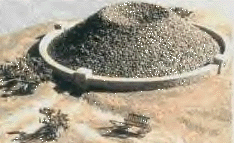This thread and
rock walls in Colorado really caught my interest. Following Robert's link to the previous thread on
Dew Ponds led to several fruitful links. There's also a great
Air Well - collecting water from the air thread on the permies homesteading forum.
Air well (condenser) on Wikepedia is worth reading. There's even an
International Organization For Dew Utilization; it's not clear their website has much practical (for pemies) information but it does list a lot of books and scholarly papers and some links to commercial products. I'm amazed at the long and ongoing history of human ingenuity applied to the prospect of harvesting atmospheric moisture. I'm most appreciative of this opportunity to increase my understanding of the possibilities here.
The ancient Greeks were very knowledgeable about harvesting atmospheric moisture. At least 50 towns had massive piles of stones to collect drinking water. In African deserts they dug tunnel into slopes to promote condensation by cooling the air. Here a photo of a reconstruction of huge mounds of rock--10,000 sq. ft. and 30-40 feet high--found in Ukraine and presumably used to harvest water from the air.

The engineer who built it estimated it would harvest 500 to 1000 gallons of water a day, but the results were less than a tenth of that at the time he abandoned the project. Study of similar piles used by the old Greeks for the water supply of the town of Theodosia on the Crimean Peninsula, indicate that such a pile would yield more than 500 gallons of water a day. In the early twentieth century, several me constructed masonry buildings with openings to foster natural air flow inside and then around masses of sandstone and slate in an attempt to maximize the operation of these ancient stone mounds. It doesn't appear that the effort paid off in improvement over the ancient ways.
There are indications that rocks aren't the best collectors--the best dew collectors are good insulators but poor conductors. Blades of grass collect more dew than pebbles on the ground. Also a smooth surface facilitates maximum drippage. Calice Courneya patented an air well using 3" pvc pipe buried up to 9 feet in the ground:
He used a fan to move air through the contraption and found that "at 90oF and 80% Relative Humidity (RH), the air well yields about 60 lb water daily. At 20% RH, the yield is only about 3 lb/day. The yield is even lower at lower temperatures." Elsewhere I read that above referenced stone constructions work best where air temperatures remain above 65.
There have been some large fog collection projects in South America. "The ideal location for fog collecters are arid or semi-arid coastal regions with cold offshore currents and a mountain range within 15 miles of the coast, rising 1,500 to 3,000 feet above sea level." They utilize an inexpensive plastic mesh and pvc piping:
http://www.rexresearch.com/airwells/fogtofo.jpg Some have been in place for 10 years or more. They capture and average of 3 litres of water per square meter of fabric each day. The pictured project in Chile fell into disrepair due to lack of buy in from the local population who preferred a more conventional industrial pipeline that cost much more of someone else's money.
More encouraging is this from
Rethinking Water: A Permaculture Tour of the Inland Northwest by Kyle Chamberlain:
Kyle noticed that in the steppes of southeast Washington about the only places that stayed green in summer and where he could find serviceberries were the north sides of the numerous piles of basalt. Botonists had already discovered this phenomenon and named such an area a “talus garland community”. He proposed this list of reasons why these piles of rocks work:
Shade from the southern sun minimizes evaporation and causes winter snow to melt later in the year
Drifting snow collects in the loose rock
Piled stones condense moisture from night air (thanks to the Designers Manual for the hint)
Stones protect soil moisture from sunlight and arid air
Stones minimize competition from grasses
Stones protect plants and debris from fire
Freshly eroded basalt provides ample mineral nutrients
Stone provides an ideal growing surface for lichens, which speed the breakdown of rock and fix nitrogen (lichens are the primary nitrogen fixers in some deserts)
Loose stone provides some protection from browsers, especially during early growth
Stone piles provide habitat for animal associates, like packrats, cottontail rabbits, marmots, chipmunks, snakes, lizards, etc. Animal associates distribute seeds, provide manure, control pests, ext. (Rabbits and marmots are very tasty themselves)
My conclusions. If I was in a dry area that has significant fog I'd look into those mesh collectors seriously. It's said 48 square feet of collection might yield 50 gallons of water a day at a cost for the mesh of $400. Elsewhere I like the potential for talus garland where you want some trees on a north slope and there are a bunch of rocks handy. Also rock mulches work.

 1
1






































